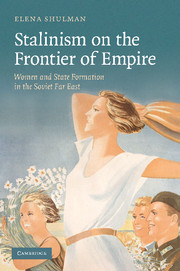Book contents
- Frontmatter
- Contents
- List of illustrations
- Acknowledgments
- Glossary
- Note on the text
- Introduction
- 1 Women and Soviet power
- 2 “Where steel cracks like glass”
- 3 “Our famous Valia”: the rise of a Soviet notable
- 4 “Envy for everything heroic”: women volunteering for the frontier
- 5 “Bol'shevichki were never ascetics!”: female morale and Communist morality
- 6 Snivelers and patriots
- Conclusion
- Appendices
- Selected bibliography
- Index
2 - “Where steel cracks like glass”
Published online by Cambridge University Press: 19 July 2009
- Frontmatter
- Contents
- List of illustrations
- Acknowledgments
- Glossary
- Note on the text
- Introduction
- 1 Women and Soviet power
- 2 “Where steel cracks like glass”
- 3 “Our famous Valia”: the rise of a Soviet notable
- 4 “Envy for everything heroic”: women volunteering for the frontier
- 5 “Bol'shevichki were never ascetics!”: female morale and Communist morality
- 6 Snivelers and patriots
- Conclusion
- Appendices
- Selected bibliography
- Index
Summary
Women were scarce in the frontier societies of the Far East. The region's sex ratio – seventy-three women for every hundred men in 1937 – was a major improvement on the state of affairs in previous decades, but, such an imbalance still generated dilemmas unknown in other rural areas of the Soviet Union. The shortage was touted by journalists as a veritable Achilles' heel of a critical border zone. A deficit of women affected family and community formations, and it proved detrimental to the functioning of industries and regional institutions where quotas for female labor went unfilled. Moreover, the visible absence of women tended to add an air of impermanence and ambiguity to the Soviet claims on the Far East because women's presence as wives and mothers often serves to “mark” the boundaries of the nation in patriotic discourses. The dictates of full-scale industrialization in the 1930s and international tensions made the dearth of women on this frontier a matter requiring attention at the highest levels of the Stalinist regime.
The imbalance between the sexes and its economic and social ramifications were, to a large extent, fallouts of state policies. Now Soviet bureaucrats, spurred by plan targets for rapid Far Eastern development, tried to engineer an immediate solution by appealing to young female activists. There was nothing remarkable about this intervention into settlement dynamics – hundreds of years before the Bolshevik Revolution, the Russian state sought to control, channel and exploit planned and anarchic population movements on the peripheries – except for the special appeal to women.
- Type
- Chapter
- Information
- Stalinism on the Frontier of EmpireWomen and State Formation in the Soviet Far East, pp. 50 - 84Publisher: Cambridge University PressPrint publication year: 2008



